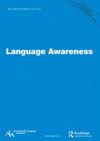Continuous speech segmentation by L1 and L2 speakers of English: the role of syntactic and prosodic cues
IF 2.2
2区 文学
0 LANGUAGE & LINGUISTICS
引用次数: 1
Abstract
Abstract We investigated how native and fluent users of English segment continuous speech and to what extent they use sound-related and structure-related cues. As suggested by the notion of multi-competence, L1 users are not seen as ideal models with perfect command of English, and L2 users not as lacking in competence. We wanted to see how language experience affects speech segmentation. We had participants listen to extracts of spontaneous spoken English and asked them to mark boundaries between speech segments. We found that in chunking authentic speech, both groups made the most use of prosody, with L1 users relying slightly more on it. However, the groups did not differ in segmentation strategies and performed alike in efficiency and agreement. Results show that in line with multi-competence, native speakers do not have an advantage over fluent speakers in higher-level speech processes, and that the outcome of natural speech comprehension does not significantly depend on the different language experiences at high levels of fluency. We suggest that research on speech segmentation should take natural continuous speech on board and investigate fluent users independently of their L1s to gain a more holistic view of processes and consequences of speech segmentation.英语一、二语使用者的连续语音分割:句法和韵律线索的作用
摘要我们调查了母语和流利的英语用户如何分割连续语音,以及他们在多大程度上使用与声音相关和与结构相关的线索。正如多元能力的概念所表明的那样,一级用户并不被视为具有完美英语能力的理想模式,二级用户也不被视为缺乏能力。我们想看看语言体验如何影响语音分割。我们让参与者听一些自发的英语口语片段,并要求他们标出演讲片段之间的界限。我们发现,在对真实语音进行分块时,两组都充分利用了韵律,L1用户对韵律的依赖程度略高。然而,两组在分割策略上没有差异,在效率和一致性方面表现相似。结果表明,在多能力的情况下,母语者在更高层次的言语过程中并不比流利者具有优势,自然言语理解的结果在很大程度上不取决于流利程度下的不同语言体验。我们建议,对语音分割的研究应该考虑自然连续语音,并独立于L1对流利用户进行调查,以获得对语音分割过程和结果的更全面的看法。
本文章由计算机程序翻译,如有差异,请以英文原文为准。
求助全文
约1分钟内获得全文
求助全文
来源期刊

Language Awareness
Multiple-
CiteScore
3.70
自引率
10.00%
发文量
18
期刊介绍:
Language Awareness encourages and disseminates work which explores the following: the role of explicit knowledge about language in the process of language learning; the role that such explicit knowledge about language plays in language teaching and how such knowledge can best be mediated by teachers; the role of explicit knowledge about language in language use: e.g. sensitivity to bias in language, manipulative aspects of language, literary use of language. It is also a goal of Language Awareness to encourage the establishment of bridges between the language sciences and other disciplines within or outside educational contexts.
 求助内容:
求助内容: 应助结果提醒方式:
应助结果提醒方式:


